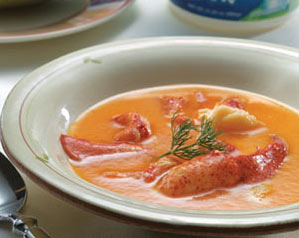September 2010
When it comes to something as simple as lobster stew, the debate is complicated. Even so, there’s nothing more satisfying than a big,
hearty bowl.
by Judith Gaines
 Lobster stew is the most curious of culinary icons. Everyone seems to agree it is a treasured dish of almost mythic status, beloved by generations of Mainers.
Lobster stew is the most curious of culinary icons. Everyone seems to agree it is a treasured dish of almost mythic status, beloved by generations of Mainers.
“It’s a classic,” says Chef Harding Lee Smith, who periodically offers it as a special at his Grill Room and Front Room restaurants in Portland.
“It’s the real Maine experience,” says Cal Hancock, head of Hancock Gourmet Lobster in Cundy’s Harbor, whose lobster stew won a gold medal in 2007 from the National Association of Specialty Foods. “If you live in Maine, it’s real comfort food. It’s the best thing since sliced bread.”
Trouble is, no one can agree on exactly what it is.
Some take a minimalist view. They sauté chunks of cooked lobster in butter, add it to warmed cream with salt and pepper, and serve it immediately with a dollop of butter floating on top. “I don’t think anybody can improve on that,” says George Olson, who offered a demonstration of his technique at Uncle Kippy’s, his restaurant in Lubec.
Others insist, equally fervently, that it isn’t lobster stew without paprika (which intensifies the reddish color), a good lobster stock to enhance the flavor, and perhaps some sherry, an elegant touch.
Succulent Simplicity
Lydia Shire, executive chef of Blue Sky on York Beach, makes a lobster stew she claims was a favorite of President John F. Kennedy. She boils live lobsters for five minutes, removes the meat, and saves the shells. Then she cooks the shells in a Dutch oven with sherry; adds milk, cream, paprika, salt, and pepper; and refrigerates the mixture overnight to let the flavors develop. The following day, she cooks the shelled meat with butter and more sherry, adds the cream mixture, heats until warm, and serves her “JFK Lobster Stew” garnished with parsley.
By using the shells, Shire comes close to making lobster bisque, which is sometimes confused with lobster stew because both are cream-based. But bisque involves cooking the shells and then grinding them into a paste which is added to the soup, or making a roux. Bisque also can be thickened with rice, which is strained or pureed in the final stages of preparation. The end product is thicker and redder than lobster stew.
Lobster stew, of course, isn’t really a stew, which typically involves slow-cooking meat or seafood with vegetables and thickening the liquid with flour to make a gravy.
Establishing the key ingredients in lobster stew can be as controversial as debating politics or religion, and partisans feel no less passionately about their views. Chefs and home cooks alike disagree about whether lobster stew should contain onions, or garlic, or a little dry mustard, or potatoes…and the list goes on. Harding Smith makes a version with lobster tomalley and roe “to give it depth.” Cal Hancock’s award-winning stew was inspired by her grandmother–a traditional version enhanced with lobster stock, spices, and a little tomato paste. “My grandmother always said, ‘Don’t do anything to hide the taste of the lobster,’” Hancock recalls. “It’s a delicate balance.”
And a tricky one. Trying to find the perfect lobster stew can seem like the search for the Holy Grail. Is the dish too creamy or too milky? Too thick or too thin? Too simple to make or too complex? Does it have the right ratio of lobster to liquid? (The consensus seems to be 40 or 50 percent, but this is a subject of debate, too.) And should the stew be served right away or refrigerated for a while so the lobster flavor infuses it more fully? The Maine Lobster Council touts about a dozen recipes with names like “Classic Maine Lobster Stew,” “Maine Lobster Stew,” “Maine Lobsterman’s Stew,” and “The Ultimate Maine Lobster Stew”–all very different, and all with their enthusiastic advocates.
Tasty Rebellions
Lawrence Klang, chef de cuisine at Natalie’s in Camden, describes himself as “kind of down” on traditional versions of lobster stew, which he finds “heavy-handed and a little boring.” He enjoys cooking Maine’s premier crustacean but prefers to make a “Thai-style lobster stew” with stewed tomatoes and shallots, white port, ginger, green curry paste, turmeric, saffron, kaffir lime leaves, and a vegetable stock with fresh carrot juice, all finished with a bit of preserved lemon. This elaborate dish is “complex but light” and showcases the talents of a professional chef, he says. “Personally, I don’t want people to come to my restaurant and pay for something that’s easy to make at home.”
Similarly, Chef Jeff Buerhaus of Walter’s in Portland says he enjoys a fairly traditional version of lobster stew at home, but at his restaurant he likes to offer “a Caribbean and Mediterranean twist.” His lobster stew has “sweet chili, wild boar bacon, purple Peruvian potatoes, and sweet potatoes; it’s sweet, smoky, and savory,” he says. With so many potatoes, most people would call this a lobster chowder. But who’s to say?
Cracking the Case
The origins of “authentic” lobster stew remain obscure. According to one history, lobster stew became widely popular after about 1910, when a bowl of it–intended for the servants–was accidentally sent to the table of John D. Rockefeller Sr. and his guests. There “it was rapturously received” and quickly became a family favorite. “In New York, what was good enough for John D. was good enough for the rest of society,” writes author Linda Stradley in What’s Cooking America.
But clearly lobster stew was created long before then. There are recipes for it in The Boston Cooking School Cookbook of 1884 and even Robert May’s The Accomplisht Cook, published in London in 1685. In the 1685 version, May sautés chunks of cooked lobster in butter and then heats this for half an hour in a mix of claret, butter, nutmeg, and orange slices.
Some Mainers suspect it was adapted here by budget-conscious fishermen’s wives, who laboriously picked the meat from lobster bodies and “stewed“ it in creamy milk–which was readily available–with just a few spices for a quick, easy, and economical meal. “It was a great way to use leftover lobster,” says Chef Larry Matthews of Portland’s Back Bay Grill, who recalls his grandmother made lobster stew this way. Who would have guessed the dish was headed for stardom?
Lubec is a little fishing village with around six very different restaurants. One of the few things they have in common is lobster stew on the menu.
“You have to,” says George Olson, who’s been the cook (not chef, he insists) at Uncle Kippy’s for 26 years. “If you don’t have it, people will go somewhere else.”
“I’ve tried everything, all kinds of variations,” Olson continues. “But my mother made it, and I do it the same way. The only secret is to use lobster that is fresh, really fresh. That’s what Maine is all about.”





0 Comments
Trackbacks/Pingbacks